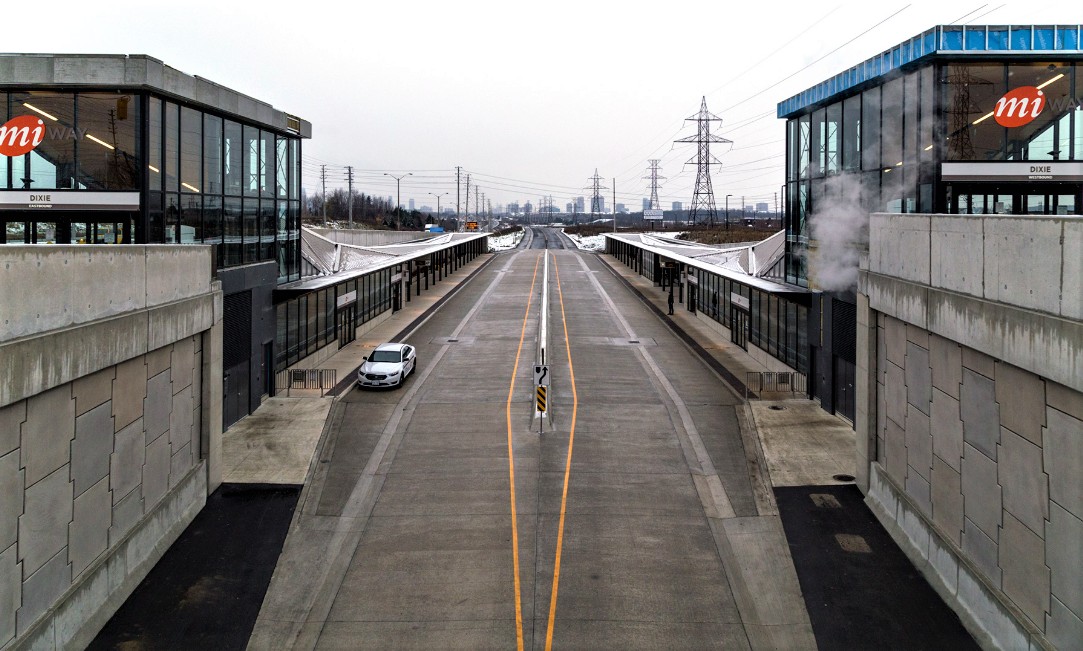
Is Mississauga’s $528M Transitway worth it? We don't know, yet
In the 1970s, visionary planners in Mississauga suggested a new kind of road – one without cars.
In 1992 that plan was conceived.
At the time, in a sprawling city with neighbourhoods planned along major highways, the idea was revolutionary. It suggested a city committed to public transit and alternatives to the car. Instead of favouring suburban-style development plans, it gave Mississauga a chance to be a North American leader in sustainable urban planning.
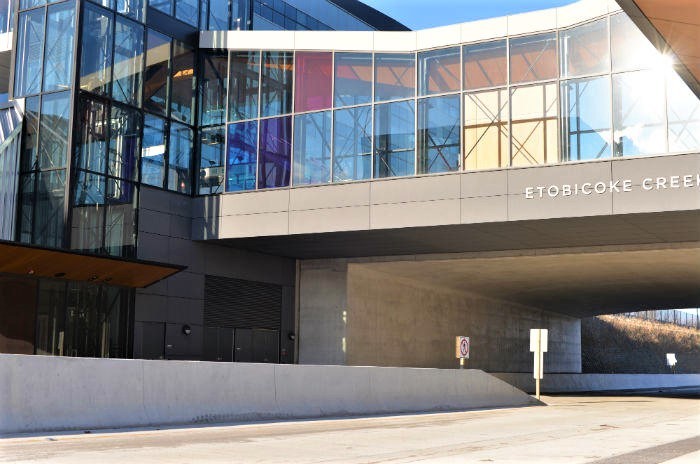
However, somewhere along the way, the tone changed. A project seen as visionary in 1992 did not receive the same vote of confidence when shovels finally went into the ground 18 years later in 2010. By 2014, only part of the project was ready and it was significantly over budget. In 2017, the project was just about complete, though plans allowed for possible expansion.
In the time between the original renderings and the finished project, much had changed. Justin Trudeau went from university student to prime minister. Climate change morphed from an obscure topic to the biggest issue facing the planet.
The full Mississauga Transitway opened in November 2017.
The Mississauga Transitway map
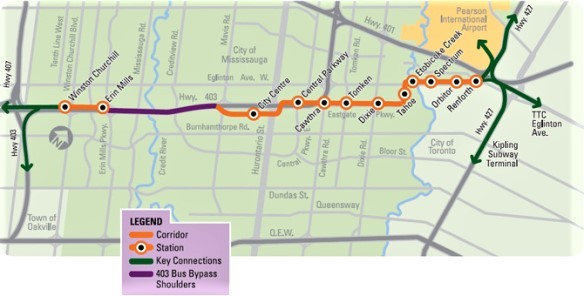
At first, Mississauga expected to contribute $123 million to the project, but because of persistent cost overruns it invested an additional $20 million. The province’s original commitment of $72 ballooned to more than $200 million, while the federal government pitched in $83 million. The mounting costs reached $528 million by the time the Transitway was completed. For the money, almost twice the amount of the approved bid, the BRT corridor was expected to be a roaring success.
In its first year, the new bus corridor moved just 8,022 daily riders. Put in context, Hurontario Street averages around 22,000 daily transit riders, while Dundas Street has around 6,000 daily riders per route on three separate services for about 18,000 in total. The 42 route, along Derry Road, has 6,700 daily riders, while the number 3 along Bloor Street carries around 7,700.
In its first year, despite its price and advertised shorter commute times, ridership figures for the Mississauga Transitway, the first-of-its-kind designated bus corridor in the GTHA, with a price tag above a half billion dollars, were significantly behind many traditional routes with next to no capital cost.
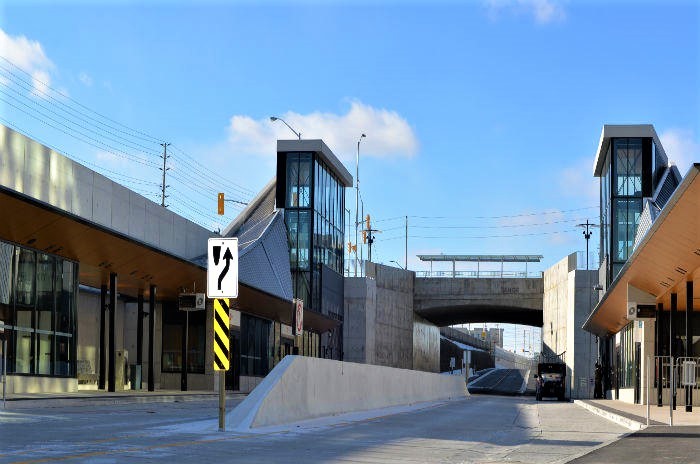
Fast forward to 2018 and while the average number of rides increased on the Transitway to more than 16,000 daily riders – 12 percent of all daily trips across the system, those numbers appear to be inflated by changes to the routes now using the BRT corridor.
The services currently operating on the transit corridor, which runs parallel to the Highway 403 at points, are the 100 Airport Express, the 107 Malton Express, 109 Meadowvale Express, the 110 University Express and service 87 at rush hour. Figures obtained by The Pointer show how those riders are divided. The Airport Express has just 1,269 daily weekday riders, while the University Express has 5,615 daily passengers. The Meadowvale Express has the highest ridership at over 8,000 daily riders, while the Malton route has around 7,000.
These ridership numbers, however, don’t necessarily show how many passengers are on the Transitway itself. The University Express, for example, services Erin Mills, Malton and University of Toronto Mississauga before it enters the rapid transit route, suggesting numbers for the Transitway itself could be considerably lower. The Malton Express too serves Humber College and Westwood Square Mall through to the Pearson Airport corridor before it enters the designated BRT route.
Where once it looked as if the Transitway would be a hugely expensive vanity project, a molted feather in the cap of those who championed it over the three decades throughout its conception, design and construction, its improved integration into the transit network appears to be gaining traction. Sure, it’s not the city-changing project it promised to be, but it may not be a continuous drain on resources either.
One urban planning expert told The Pointer that Mississauga’s Transitway has a fundamental problem. “I think the bus rapid transit (BRT) was built in the wrong place,” Gil Penalosa, President of 8 80 Cities, says. “A route along Burnhamthorpe [Road] should have been given priority, unless your focus is moving people between cities like Markham and Hamilton [where a bus bypass route makes sense]. In Mississauga, the vast majority of trips are done by car, [so] priority should be given to public transit. Due to its location, closer to denser neighbourhoods, Burnhamthorpe would have given even higher ridership [than the Transitway now has]. It has six lanes through most of Mississauga, meaning that you could add a BRT in one lane in each direction.”
Rendering of Burnhamthorpe Road in Mississauga as a major transit corridor
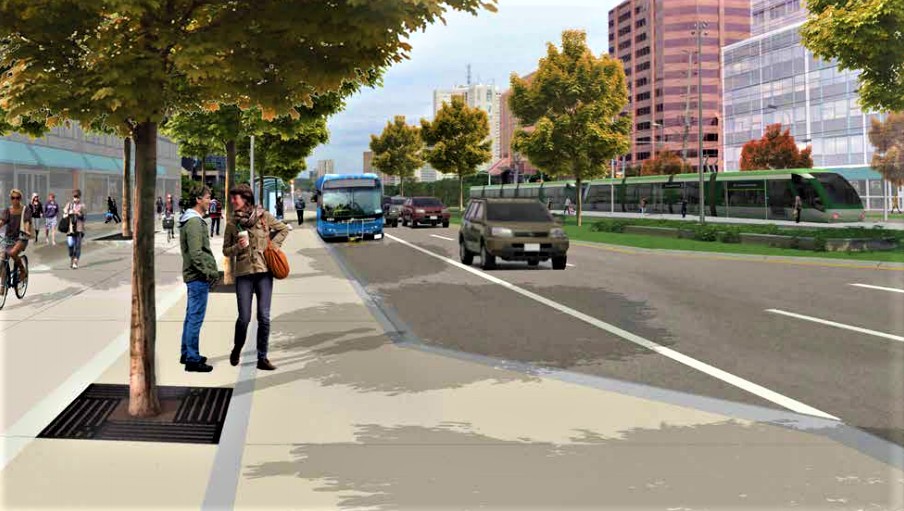
That would have cost a tiny fraction of the $528 million spent on the Transitway, but there’s no sense trying to undo what can’t be undone. The question is, how can the city get the most from its unique, but poorly utilized designated bus corridor.
“Of course, the BRT is a good thing – almost anything you do with public money to improve transit is good,” Penalosa added. “The question is could you have done something better with the money. If the decision had been to run the BRT down Burnhamthorpe you could have had ten times as many passengers, but ultimately, they did not have the guts to tell cars to move out [by reducing their laneshare], so they settled on the 403.”
That appears to be the crux of the problem. At one point the Transitway looked set to be an utter failure; now, in 2019, it does play a role in MiWay’s overall route capacity and likely cuts down on trip times. Yet, few can explain why Highway 403 was targeted as a transit priority ahead of Dundas, Burnhamthorpe, Bloor or Hurontario, or even Lakeshore.
The rising ridership on the Transitway, which is also used by a series of GO buses, is a testament to the work MiWay has done to expand its use since opening the corridor. It is also evidence of poor planning. For just 8,000 or so people to use the route every day in its first year suggests it was built in a location with limited demand, while other routes with far higher ridership had thousands of commuters on buses stuck in traffic. As suggested by Penalosa, its proximity to Highway 403 and east to west nature makes it the perfect route for intercity buses to bypass Mississauga and traffic snarls – it does not make it particularly useful for transit within the city itself.
Recently, the city put forward a funding request to the federal government to help pay for construction of a BRT on Dundas and Lakeshore, while the Hurontario LRT is due to break ground in the spring. These projects leave Mississauga within touching distance of a genuine rapid transit network reaching many corners of the city and benefitting residents across its expanse. In the context of those routes being completed, the Mississauga Transitway will play an important role, connecting with the Hurontario LRT among others.
However, when shovels finally went into the ground in 2010 to build the Transitway, the Hurontario LRT was a pipedream and neither Dundas nor Lakeshore were publically earmarked for BRT corridors.
Through this lens, Mississauga’s fraught relationship with public transit is made clear. Before the turn of the century a revolutionary idea was floated inside city hall, one which was lofted from one department to another until it was finally ready to construct roughly 20 years later. Yet, during those 20 years, things changed. Density began to arrive in areas of the city, meaning a BRT next to the highway became less logical. More jobs also appeared in Mississauga itself, making rapid transit towards Toronto less important and denser arteries within the city more useful. Yet, it was too late to change and the Transitway was built along a route identified many, many years before, in a totally different cityscape.
Credit should be given where credit is due. MiWay decision-makers appear to be doing a remarkable job of turning a doomed project into a city asset. Ridership is increasing, something which will only improve as the Hurontario LRT arrives in 2024.
The lesson from the Transitway, though, is one of speed and flexibility. Its opening should have been the end of the project’s core focus, not the beginning of a refocus on what it should become. The route should have been nearly full. Instead, for two years, MiWay has had to think of ways to increase ridership along a stagnant corridor that came with a half-billion dollar price tag.
With future projects, like the Dundas and Lakeshore BRTs, the key will be to get shovels in the ground quickly to capitalize on current planning and to help shape future planning around higher order transit.
Email: [email protected]
Twitter: @isaaccallan
Submit a correction about this story


